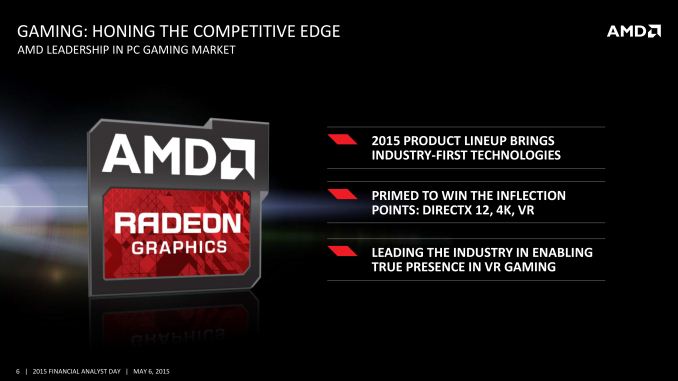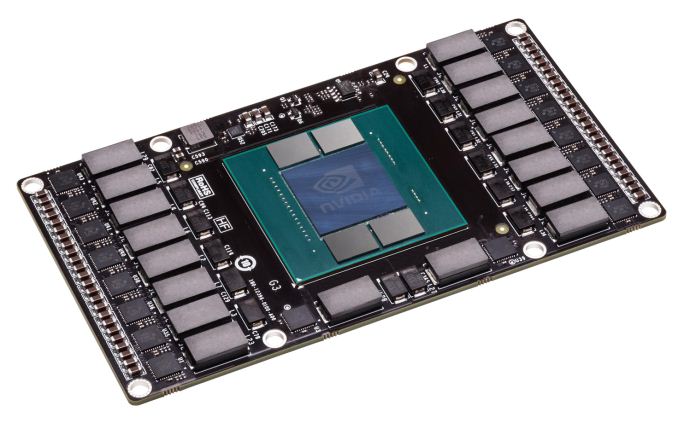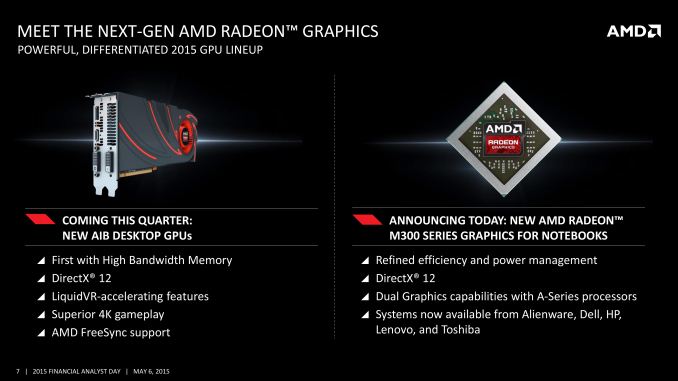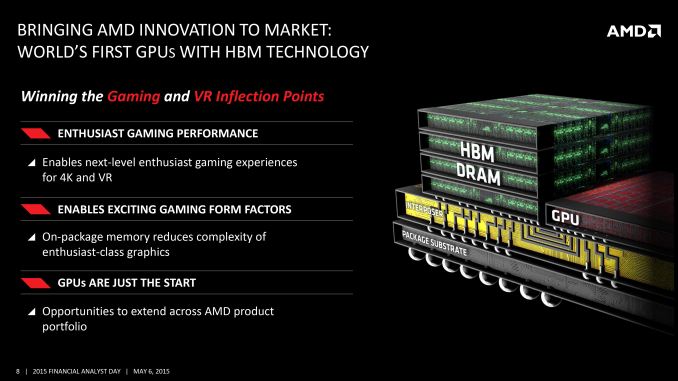AMD To Launch New Desktop GPU This Quarter (Q2’15) With HBM
by Ryan Smith on May 6, 2015 2:22 PM EST- Posted in
- GPUs
- AMD
- Radeon
- AMD FAD 2015

Having just left the stage at AMD’s financial analyst day is CEO Dr. Lisa Su, who was on stage to present an update on AMD’s computing and graphic business. As AMD has already previously discussed their technology roadmaps over the next two years earlier in this presentation, we’ll jump right into the new material.
Not mentioned in AMD’s GPU roadmap but now being mentioned by Dr. Su is confirmation that AMD will be launching new desktop GPUs this quarter. AMD is not saying much about these new products quite yet, though based on their description it does sound like we’re looking at high-performance products (and for anyone asking, the picture of the card is a placeholder; AMD doesn’t want to show any pictures of the real product quite yet). These new products will support DirectX 12, though I will caution against confusing that with Feature Level 12_x support until we know more.
Meanwhile the big news here is that these forthcoming GPUs will be the first AMD GPUs to support High Bandwidth Memory. AMD’s GPU roadmap coyly labels this as a 2016 technology, but in fact it is coming to GPUs in 2015. The advantage of going with HBM at this time is that it will allow AMD to greatly increase their memory bandwidth capabilities while bringing down power consumption. Coupled with the fact that any new GPU from AMD should also include AMD’s latest color compression technology, and the implication is that the effective increase in memory bandwidth should be quite large. For AMD, they see this as being one of the keys of delivering better 4K performance along with better VR performance.
In the process AMD has also confirmed that these HBM-equipped GPUs will allow them to experiment with new form factors. By placing the memory on the same package as the GPU, AMD will be able to save space and produce smaller cards, which will allow them to produce designs other than the traditional large 10”+ cards that are typical of high-end video cards. AMD competitor NVIDIA has been working on HBM as well and has already shown off a test vehicle for one such card design, so we have reason to expect that AMD will be capable of something similar.

With apologies to AMD: NVIDIA’s Pascal Test Vehicle, An Example Of A Smaller, Non-Traditional Video Card Design
Finally, while talking about HBM on GPUs, AMD is also strongly hinting that they intend to bring HBM to other products as well. Given their product portfolio, we consider this to be a pretty transparent hint that the company wants to build HBM-equipped APUs. AMD’s APUs have traditionally struggled to reach peak performance due to their lack of memory bandwidth – 128-bit DDR3 only goes so far – so HBM would be a natural extension to APUs.












146 Comments
View All Comments
Zefeh - Wednesday, May 6, 2015 - link
I ain't gonna do what I did again for other cards, but I'm quite sure AMD has competed pretty evenly in the GPU market since the 4000 series and you basically disregarded them in that post.What you just said - "They've increased preformance something like five-fold" can also be said for AMD. You blatantly disregard that AMD has its own points of success, just focusing on Nvidia bonuses! "Nothing short of miraculous"? Its a company doing what its supposed to do, natural progression of technology...
To be honest, I'm a consumer that runs 2 HD displays and a 3rd incoming. I am no datacenter and I am no dude working on multi-million dollar systems. I get these GPU's to game and there's a reason why I buy a GPU - performance/cost ratio. Titan's cost is stupid, its performance is comparative to AMD at $300+. I don't give a crap that power has been cut, I care about cold hard performance. Drivers have NEVER been an issue for me with AMD and I've been with them since the HD4870. The people I recommend AMD GPU's to also don't have a problem. What you are spewing is just random things that are expected of companies...
You want to know whats "Nothing short of miraculous"? The fact that AMD hasn't been making a net profit as a company for YEARS and is STILL a better performer than Nvidia minus the corporate world (Because they just don't have those resources).
chizow - Wednesday, May 6, 2015 - link
Wow so you go straight from normal coherent comparisons to AT Bench to driving off the deep end lol.Same can't be said for AMD, yet, sorry. Nvidia has pulled the rabbit from the hat on 28nm, not once, but twice. We have no idea if AMD will be able to perform the same feat, but from the looks of some of these announcements today, it is not looking so good.
But I'm a consumer too when I'm off work, I just wanted to make it a point that the data center I run is just one of tens of thousands in the world that are filled with Intel and Nvidia solutions, despite the hopes, dreams and testimony of AMD fanboys.
But since you are an AMD user and run 2 screens, you should be able to tell me. Did they fix that full clock/high power issue yet with more than 1 screen? Because they hadn't fixed it as of 2 months ago when I had that 290X. Just wondering.
But yeah, Titan performance is comparative to AMD at $300? Get real man, seriously, you'll be lucky to see that level of performance from AMD at that price point next generation. The fact AMD hasn't turned a net profit and performed so poorly in the marketplace is why they're a fraction of the size they were even 4 years ago, and why today's announcement is flush full of rebrands rather than new components and new products.
They've gambled their resources in a lot of the wrong areas, and while they have generally been competitive in raw performance and certainly in price, the market simply isn't interested in their products. AMD fans will insist its something ethereal like marketing, but the the market simply prefers better products which often comes down to features and support when price:performance are close.
looncraz - Friday, May 8, 2015 - link
nVidia had the same "bug" if you recall. However, yes, they fixed that "bug." Also, anyone who knew anything would just run special idle profiles. I still do this, which saves quite a few watts from the standard profile (AMD should really do this by default, there is no reason to push the memory clocks to full at any point in time in 2d outside of a few specific applications).chizow - Saturday, May 9, 2015 - link
@looncraz, the key word is Nvidia HAD. But they addressed it within 3 months of inventing the feature to downclock and reduce power while in desktop mode with Fermi in 2010. AMD not only took longer to implement their own version, but it is still NOT FIXED. See the difference? We are not talking 3 months to get their drivers in order, we are talking like 4 years now.You keep putting "bug" in parens as if you don't acknowledge this as a problem, it is obvious this kind of attitude is what results in a non-fix for AMD users. Their users just accept it and blow it off, like dozens of other major issues, so they just never get fixed.
Also, custom profiles don't work, because contrary to what you claim, downclocking the memory does result in major issues like flickering screens, lag, and outright loss of range on monitors, which is most likely why AMD has to keep their memory clocks at full and their GPU clocks high to begin with.
Hicks12 - Friday, May 8, 2015 - link
Sorry but what is that five fold increase tested against? Since we're on anandtech let's use their benchmarks.. http://www.anandtech.com/bench/product/1135?vs=118...I don't know why you compare the titan x to a 480 as the price is stupidly different, just because the year of release is different doesn't warrant excluding the price price difference.... Gtx 480 was $500 and the titan x was $1000.... Yeah that's not valid comparison.. Even still the benchmark shows less than a 3x improvement (sorry it's a titan black ha). Let's compare the gtx 980 to the 480 as that was $550 so very close in price.... Oh look it's much closer to 2x performsnce.. And I have just checked the 5870 against the 290x and its pretty much identical in improvement so really don't sit on that nvidia high horse as both teams have made good progress.
chizow - Friday, May 8, 2015 - link
I'll be gentle with you since you are not just an AMD fan, but also appear to be very young as well from some of your less than coherent ramblings. :)So as you can see in my original comparison, I was drawing a comparison between what has been accomplished on 28nm, which is just 1 process node away from 40nm. GTX 480 was Nvidia's first flagship on that node. Titan X (GM200) will be Nvidia's last flagship on 28nm. The goal was to compare how much we have advanced on just 1 process node improvement and as we can see, the results are simply astounding. Price is irrelevant, as that was simply Nvidia taking advantage of the market opportunity AMD presented with the lackluster 7970.
Again, you don't seem to be able to follow the relevant parts being compared here. Titan Black is 3x faster than 480, which is what you would expect as typical from one process node to another. But Nvidia pulled a pretty amazing feat on 28nm and pulled a rabbit out of the hat again with Maxwell. Titan X is ~1.7x faster than Titan Black, so 3*1.7=5.1x which is exactly as I said. That's what AMD still has left to take care of leaving off from the 290X, they have the difficult feat of pulling off similar while reducing or maintaining current thermals, which is clearly going to be an uphill battle for them given how hot and power hungry Hawaii was to begin with.
Before you reply, please take a moment to read and really understand what I wrote, you might actually learn something. :)
looncraz - Friday, May 8, 2015 - link
Not just nVidia's superior marketing, but also AMD's unfortunate image of being the "affordable" option. AMD BADLY needs to shake this image. They need to make themselves appear to be all about quality. They very well may need to create new product brands that downplay the AMD connection entirely to do this.I buy AMD because my experience with nVidia products is usually more frustrating. This is partly because AMD exposes options nVidia does not (the inverse is also true), and also partly because I'm simply more familiar with AMD's more recent hardware.
I run specialized profiles for my R9 290 that gets me in BF4 ultra@1080@60hz at a v-sync locked 60fps while drawing only 300 watts. My 7870XT (cut down 7950) would pull 330 watts and not perform nearly as well. The 290 outperforms the nVidia 780 system I built for a customer AND pulls less power (while gaming anyway, the 780 wins on idle, albeit not by much).
chizow - Saturday, May 9, 2015 - link
@looncraz, I agree with that 2nd part that AMD has been billed as the cheap, value brand, but that's really none other than AMD's fault. I said it when they launched the 4870, that hey badly underpriced that part relative to how it performed and despite evidence that shows this, AMD fans still claim otherwise. While it was true AMD need to capture mind and market share from Nvidia, they dug themselves a hole they have yet to climb out of. Only after they briefly took the lead with the 7970 did they finally make their move to raise their product stack, but it was ill-timed and ultimately allowed Nvidia to jump their entire product stack up an entire SKU level while creating a super premium part in Titan with their biggest ASIC.As for the marketing bit, again, people seem to think marketing is the equivalent of nothing or fluff. I fully disagree. You can't effectively market your products if you don't have the goods to back it up. Indeed, AMD spends a LOT of time marketing their own products, but not by demonstrating and espousing their benefits and features, but more often then not, by disparaging and their competitors. This only takes you so far, because at the end of the day, the end-user will see through any marketing and realize, Nvidia products are better because they deliver the solutions, features and support to differentiate themselves.
Similarly, I buy Nvidia because I know for a fact AMD doesn't even offer solutions for some of the features and technology I've come to rely upon. Its also a part of the reason I pay close attention to some of these releases, because AMD loves to come out of the gate swinging claiming their products WILL be better some point in the distant future, but at the end of the day you get underwhelming results, delays, or features that just fade into memory as abandonware.
Also, I'm actually pretty surprised you were able to run BF4 with Vsync on with AMD, certainly you set that in-game right? Because that's another pet peeve with using AMD, their driver-level Vsync simply doesn't work!
MisterAnon - Thursday, May 7, 2015 - link
Is it easy to be a fan of the guys who release a card like the 970 with gimped memory and equal performance to AMD's 2013 equivalent? Ouch.chizow - Thursday, May 7, 2015 - link
Sure, the 970 is still a great card, a paper spec restatement has not changed this at all. Indeed, we may look back one day and say the 970 was the final nail in AMD's coffin as it is slaughtering Radeon in the marketplace.Now, is it easy to be a fan of the guys who say so much misinformation about FreeSync before it even exists, only to have it suck and not be even close to what they claimed originally?